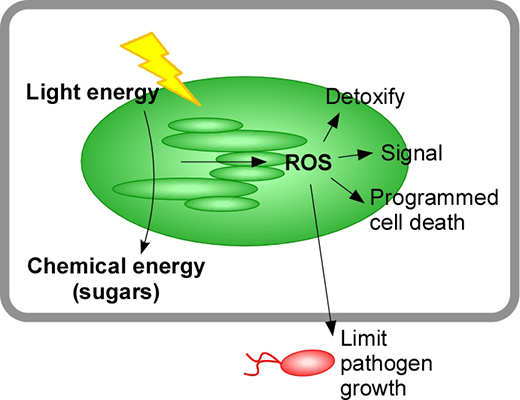Photosynthetic defence
Plants can convert sun light energy into chemical energy in a process called photosynthesis. This well-studied process is confined to specialized organelles, the chloroplasts, which contain chlorophyll pigments for light absorption. During light absorption the exited chlorophyll is highly reactive, and therefore can cause damage to the cell by generating reactive oxygen species. Therefore, plants tightly control light absorption, but also have systems to dissipate extra energy as heat and to detoxify reactive oxygen species thereby ensuring optimal energy use to produce storage sugars in a changing environment.
These storage sugars are the basis for all non-photosynthetic life. Not only we as humans feed on vegetables and fruits, but also many pathogenic microbes are attracted, and colonize plants to gain access to this energy source. Plants protect themselves against such invaders with a multi-layered immune system. In contrast to the human immune system, which relies on specialized mobile immune cells, in plants cells are immobile and therefore every cell contains the complete immune program to fight off a diverse range of pathogens.
In the last years, it has become obvious that plants employ the reactive oxygen species produced as a dangerous waste product of photosynthesis in defence against pathogens. In a rather unspecific manner, a burst of reactive oxygen species is produced by the chloroplast to kill the cells in the infected area of a leaf. This efficiently limits spreading of pathogens that depend on living host tissues.
Interestingly, besides this brute force approach by cell death, reactive oxygen species are also produced in the chloroplast in a more controlled way to limit pathogen proliferation without plant cell damage. Pathogens actively interfere with this production in the chloroplast, highlighting its importance in defence. This new finding raises interesting questions:
- How is this process triggered and subsequently controlled to avoid plant cell damage?
- How do reactive oxygen species in the chloroplast limit pathogen proliferation outside the cell?
Understanding the contribution of photosynthesis to defence against pathogens might open new routes of plant protection.
Contribution by Vera Göhre, Institute for Microbiology, HHU
Planter’s Punch
Under the heading Planter’s Punch we present each month one special aspect of the CEPLAS research programme. All contributions are prepared by our young researchers.
Corresponding publication
Göhre V (2015) Immune responses: Photosynthetic defence. Nature Plants 1:15079. [Abstract]
